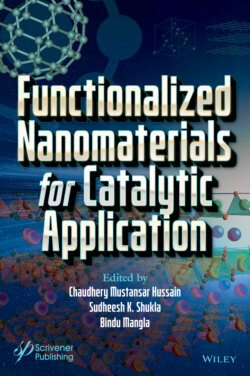Читать книгу Functionalized Nanomaterials for Catalytic Application - Группа авторов - Страница 22
1.5.1.3 Graphene (G)/Graphene Oxide (GO)–Based FNMs
ОглавлениеThe supply of graphene/graphene oxide–based functionalization resolves the constraints delivered by metal oxide PCs. Of late, attentions are focused on FNMs of graphene/graphene oxide–based semi-conductor materials as functionalized PC due to their smaller size with larger specific surface area supported by high electron (e−) conductivity and high adsorption capacity [141]. Advanced research work has been augmented on MO-G/GO FMNs photocatalytic systems [142] for oxidativereduction of pollutants (BG) [143] and (MB) [144]. The unstable and aggregation tendency of the NMs are retarded by the advantages raised due to FNMs.
In one of their studies, researchers Rao, G. et al. synthesized TiO2-NW/Fe2O3-NP/GO FNM sheets by colloid-blending scheme, where the material was found to have 93% efficacy in getting rid of humic acid from water photocatalytically at a pH 6. TiO2 furnished h+ required for ·OH and GO the e− needed for ·O2− needed for the activity [145]. GO/MCU-C3N4/PVDF materials synthesized by vacuumized self-assembly and cross-linking process had exceptional self-cleaning property, which was proven fit for separating oil-in-water colloidal emulsions. Photocatalytic degrading capabilities were attributed to the e− transferences from CB (1.61 eV) to VB (1.18 eV), with π-π* transition giving h+ in VB. h+, ·O2−, and ·OH were controllers in the reaction for eradicating oil-foulants as observed by the researchers Shi, Y. et al. [146].
Scientific workers Gnanamoorthy, G. et al. synthesized AF-Bi2Sn2O7/rGO (AF-amine functionalized) FNMs for photocatalytic degradation of organic dye MB in the visible region was 75% (20 min). Bandgap between pure (2.6 eV) and FNMs (1.6 eV) decreased. VB with h+ and CB with e− that favored the reaction were supported by the formation of radicals ·O2− and ·OH. Stability and reusability of FNMs were persistent up to four cycles [147]. In one of their methods, the authors Liu, H. et al. used FNMs of Bi2Sn2O7/RGO to reduce and degrade Rh B and phenol photocatalytically in the bright visible region (420 nm) and noticed that the degrading efficiencies were 95.8% (125 min) and 81.1% (200 min) for Rh B and phenol, respectively. On embedding RGO on Bi2Sn2O7 (pure), they observed that there was a decrease in the bandgap from 2.48 eV (pure) to 1.85 eV FNM which served well for degrading the contaminant, where the active radicals involved for the reaction was h+ and ·OH [148].
